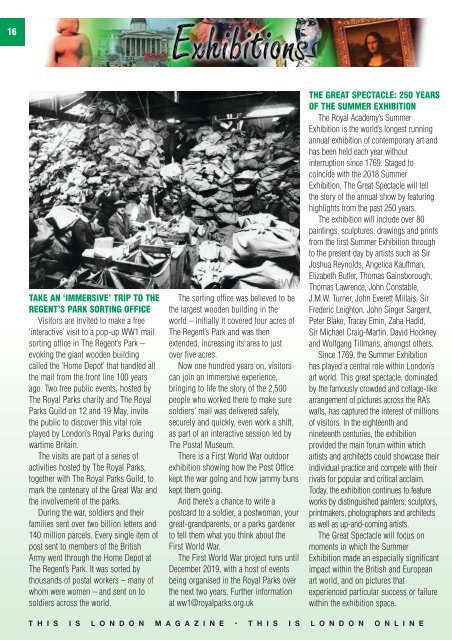Royal Wed TIL
Create successful ePaper yourself
Turn your PDF publications into a flip-book with our unique Google optimized e-Paper software.
16<br />
TAKE AN ‘IMMERSIVE’ TRIP TO THE<br />
REGENT’S PARK SORTING OFFICE<br />
Visitors are invited to make a free<br />
‘interactive’ visit to a pop-up WW1 mail<br />
sorting office in The Regent’s Park –<br />
evoking the giant wooden building<br />
called the ‘Home Depot’ that handled all<br />
the mail from the front line 100 years<br />
ago. Two free public events, hosted by<br />
The <strong>Royal</strong> Parks charity and The <strong>Royal</strong><br />
Parks Guild on 12 and 19 May, invite<br />
the public to discover this vital role<br />
played by London’s <strong>Royal</strong> Parks during<br />
wartime Britain.<br />
The visits are part of a series of<br />
activities hosted by The <strong>Royal</strong> Parks,<br />
together with The <strong>Royal</strong> Parks Guild, to<br />
mark the centenary of the Great War and<br />
the involvement of the parks.<br />
During the war, soldiers and their<br />
families sent over two billion letters and<br />
140 million parcels. Every single item of<br />
post sent to members of the British<br />
Army went through the Home Depot at<br />
The Regent’s Park. It was sorted by<br />
thousands of postal workers – many of<br />
whom were women – and sent on to<br />
soldiers across the world.<br />
The sorting office was believed to be<br />
the largest wooden building in the<br />
world – initially it covered four acres of<br />
The Regent’s Park and was then<br />
extended, increasing its area to just<br />
over five acres.<br />
Now one hundred years on, visitors<br />
can join an immersive experience,<br />
bringing to life the story of the 2,500<br />
people who worked there to make sure<br />
soldiers' mail was delivered safely,<br />
securely and quickly, even work a shift,<br />
as part of an interactive session led by<br />
The Postal Museum.<br />
There is a First World War outdoor<br />
exhibition showing how the Post Office<br />
kept the war going and how jammy buns<br />
kept them going.<br />
And there’s a chance to write a<br />
postcard to a soldier, a postwoman, your<br />
great-grandparents, or a parks gardener<br />
to tell them what you think about the<br />
First World War.<br />
The First World War project runs until<br />
December 2019, with a host of events<br />
being organised in the <strong>Royal</strong> Parks over<br />
the next two years. Further information<br />
at ww1@royalparks.org.uk<br />
THE GREAT SPECTACLE: 250 YEARS<br />
OF THE SUMMER EXHIBITION<br />
The <strong>Royal</strong> Academy’s Summer<br />
Exhibition is the world’s longest running<br />
annual exhibition of contemporary art and<br />
has been held each year without<br />
interruption since 1769. Staged to<br />
coincide with the 2018 Summer<br />
Exhibition, The Great Spectacle will tell<br />
the story of the annual show by featuring<br />
highlights from the past 250 years.<br />
The exhibition will include over 80<br />
paintings, sculptures, drawings and prints<br />
from the first Summer Exhibition through<br />
to the present day by artists such as Sir<br />
Joshua Reynolds, Angelica Kauffman,<br />
Elizabeth Butler, Thomas Gainsborough,<br />
Thomas Lawrence, John Constable,<br />
J.M.W. Turner, John Everett Millais, Sir<br />
Frederic Leighton, John Singer Sargent,<br />
Peter Blake, Tracey Emin, Zaha Hadid,<br />
Sir Michael Craig-Martin, David Hockney<br />
and Wolfgang Tillmans, amongst others.<br />
Since 1769, the Summer Exhibition<br />
has played a central role within London’s<br />
art world. This great spectacle, dominated<br />
by the famously crowded and collage-like<br />
arrangement of pictures across the RA’s<br />
walls, has captured the interest of millions<br />
of visitors. In the eighteenth and<br />
nineteenth centuries, the exhibition<br />
provided the main forum within which<br />
artists and architects could showcase their<br />
individual practice and compete with their<br />
rivals for popular and critical acclaim.<br />
Today, the exhibition continues to feature<br />
works by distinguished painters, sculptors,<br />
printmakers, photographers and architects<br />
as well as up-and-coming artists.<br />
The Great Spectacle will focus on<br />
moments in which the Summer<br />
Exhibition made an especially significant<br />
impact within the British and European<br />
art world, and on pictures that<br />
experienced particular success or failure<br />
within the exhibition space.<br />
t h i s i s l o n d o n m a g a z i n e • t h i s i s l o n d o n o n l i n e

















